How to stand up paddle board
Dec 27, 2022
Did you know that stand-up paddle boarding, also known as supping, is the world's fastest-growing water sport? The competitive and latest trend in water sports is a fantastic way to experience the beauty of water and nature, with the added benefits of socialization, a full body workout and meditation.
Stand-up paddle boarding involves standing on a floating board and paddling yourself through oceans, rivers, lakes or bays. Best of all, it's a perfect sport for everyone to enjoy, regardless of age, skill level, where you are, body type or the type of paddleboard.
In the recent past, stand-up paddle boarding has grown in popularity due to the freedom it offers paddle boarders to explore beautiful waters.
If you're new to paddleboarding, standing up on your sup paddle board may seem intimidating. However, with some basic knowledge, techniques and practice, you'll paddle like a pro. Keep reading this article and learn how to sup.
Types of Stand-up Paddleboards
Stand-up paddle boards come in all sizes and shapes. Sup paddle boards are much thicker than the average surfboard. Typically, they range from approximately 8-12 feet in length, 4-5 inches thick and 28-32 inches wide. So, which one is the best for you? Let's find out.
-
Hard paddle boards
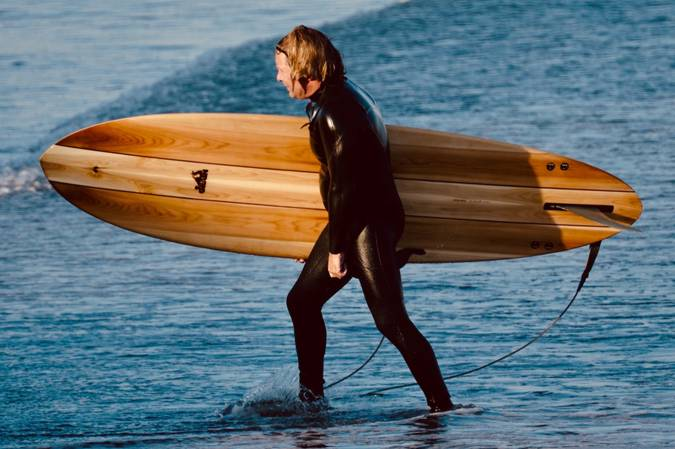
These are rigid boards that provide excellent performance and improved stability. They, however, take up a lot of space and need to be stored in a wall rack or garage and transported by car.
Hard paddle boards are best for you if performance is your priority, you have a storage place, and you are looking for stability and a perfect fit.
-
Inflatable paddle boards

Also known as blow-up paddle boards, these boards are not as firm as solid paddle boards, but when fully inflated, they are stiff and offer a convenient and fun option for getting on the water.
If the storage space or transportation is limited, an inflatable paddle board remain a great option. They are durable and roll to the size of a sleeping bag when you want to store them.
Inflatable paddle boards remain the best option if you have limited storage space, are hiking to a lake, are travelling, like SUP yoga, or are paddling whitewater.
-
All round paddle board
Also known as flatwater or recreational paddle boards, they are the most common type since they excel in various conditions. They are perfect for beginners, thanks to their versatility. They can be used for various paddling activities, including SUP fishing, SUP touring, SUP yoga, and SUP touring.
Basic Paddle Boarding Equipment
Once you've decided to start paddleboarding, you'll need a few paddle boarding gear, including a stand-up paddle, personal floatation device, paddle leash and a board bag.
-
Stand up Paddle
SUP paddles come in different constructions, including eps foam core wrapped in carbon fibre, wood or plastic. They somehow look like a stretched-out canoe paddle with a blade that angles forward for convenient and maximum paddling.
-
Personal floatation Device(PFD)
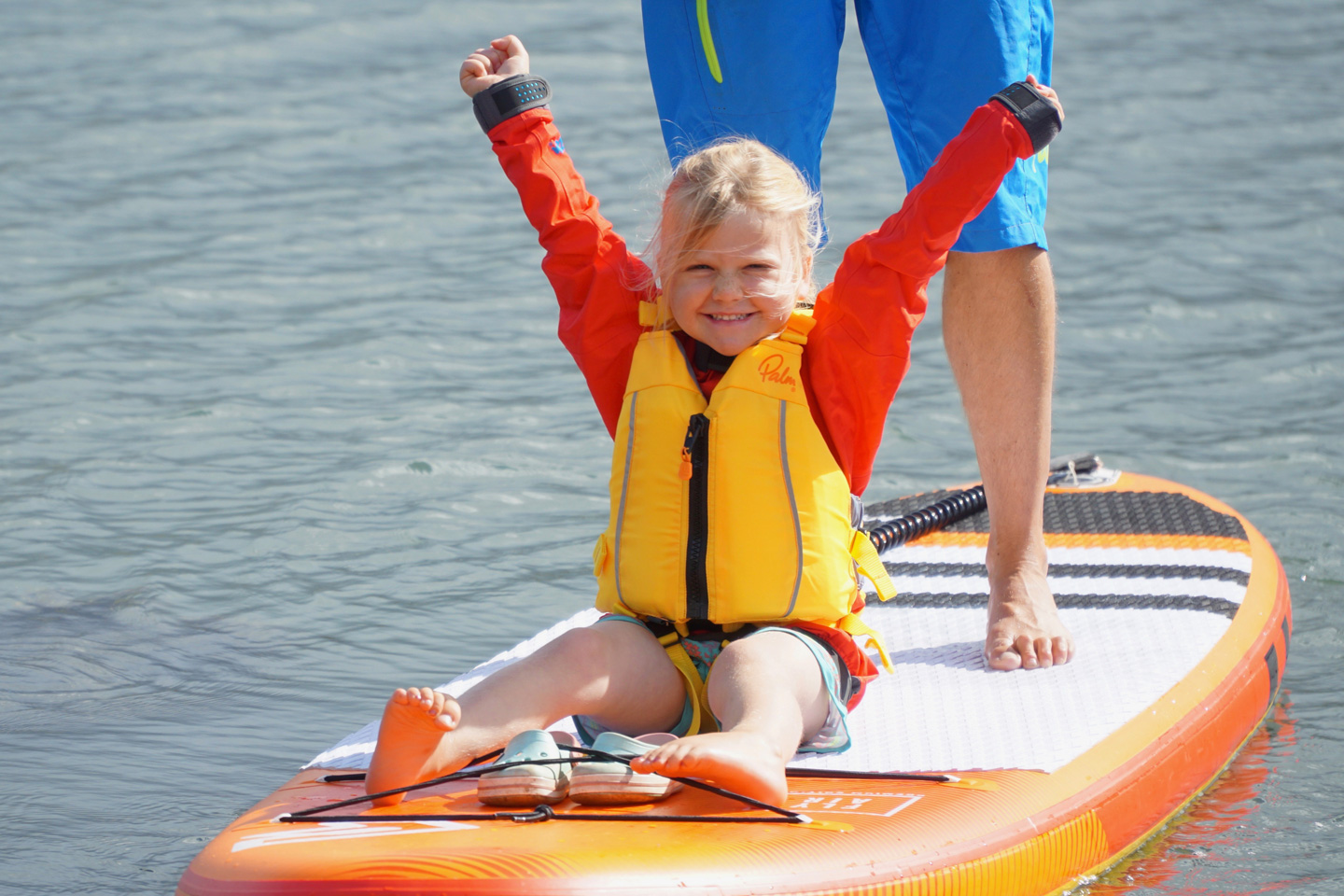
Also called a paddle board life vest, a personal flotation device is a safety device used by stand-up paddlers that go beyond the limits of surfing, paddling or recreational use.
-
Paddle Leash
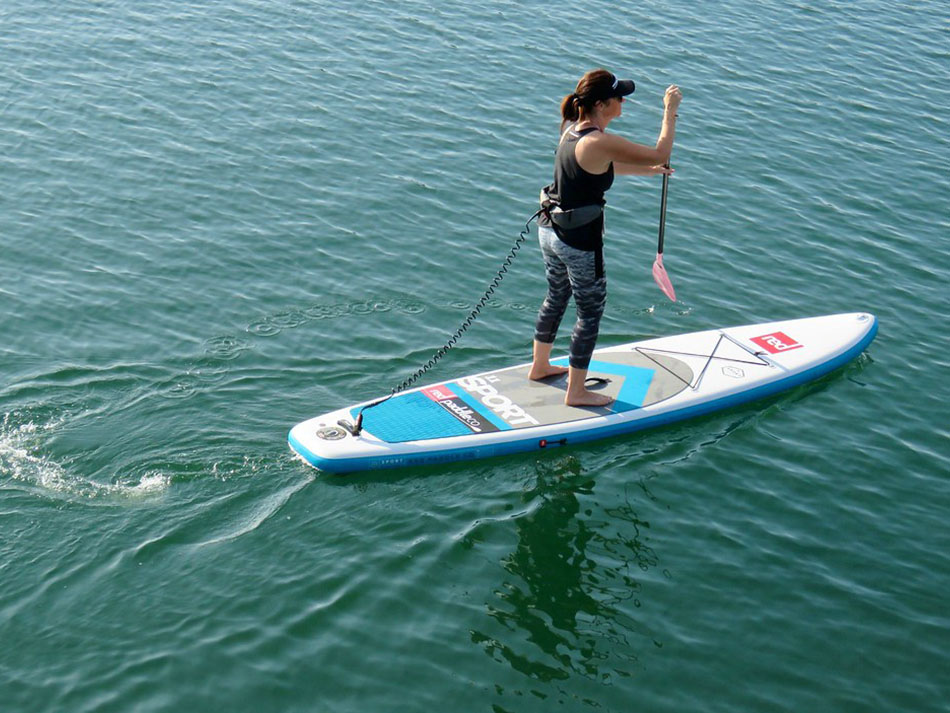
Sold separately, a paddle leash keeps the paddle board attached with a strap around your calf, waist or ankle for safety purposes. Paddle leashes come in different sizes and are designed specifically for surf, rivers or flat waters. Therefore, ensure you purchase the right one for your intended use.
-
Board Bag
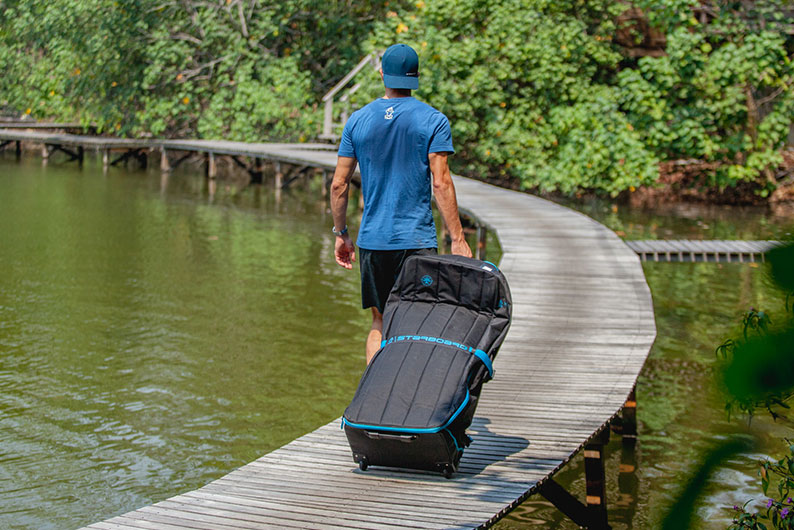
Board bags help you transport and store your paddle board conveniently. Moreover, a paddle board bag helps increase the life of your paddle board.
-
Proper Clothing
During the summer months, on warm waters, ensure to have swimsuits, short-sleeved rash guard, and board shorts for sun protection. In excellent conditions, wear a dry suit or a wet suit.
In addition, wear deck shoes, sunglasses, sunscreens and other sun-protective clothes.
Choosing Where to SUP
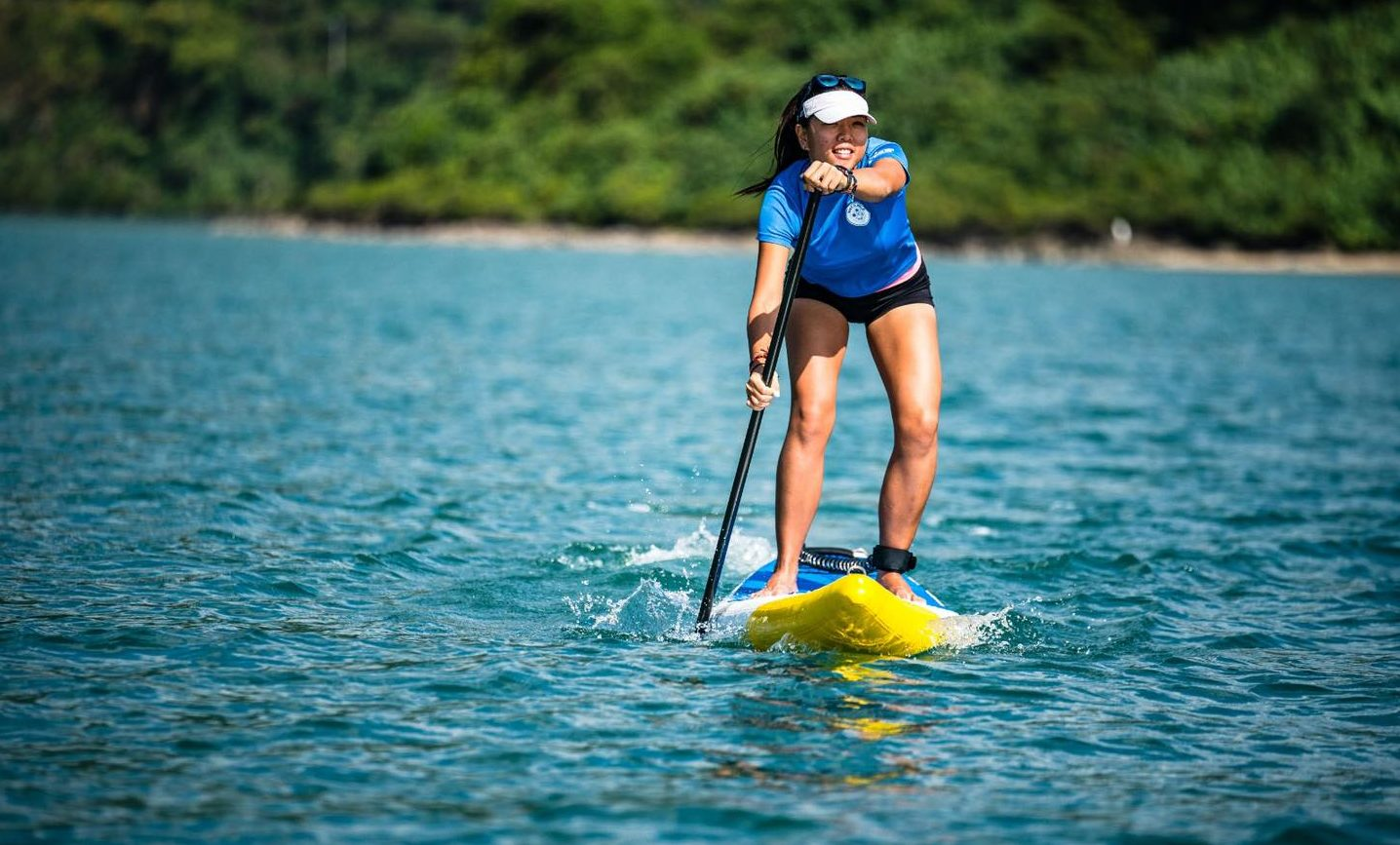
Choosing where to SUP depends on different skills and knowledge. Flat water paddleboarding is popular among beginners and paddlers looking for a relaxing experience. Here are some of the waters you can paddle board on:
-
Flat water
Ponds, lakes, harbours and calm bays offer calm and flat conditions for beginners and first-timers. The calm waters help you focus on your paddling technique and balance.
Paddle on the still waters of lakes and stick close to the shoreline, so you get back to land quickly if the need arises.
-
Moving Waters
Moving waters such as rivers add an additional element to help you paddle forward. However, ensure you check water levels and flow before paddling. Rain often changes rivers considerably and quickly. If you choose moving waters as your SUP location, ensure you know your entrance and exit points accordingly.
-
Whitewater
Whitewater paddleboarding is best suited for adventurous and more experienced paddlers. It is an adrenaline rush that requires good balancing skills and negotiating moving wears with the paddle.
Basic Stand-Up Paddling Techniques
So, you have your board, the proper attire and a paddle. You have also spotted the perfect location for your stand-up paddle-boarding trip. While there are few paddling techniques, they all revolve around using your paddle as a pivot.
The top hand drives the pivot while the bottom hand acts as the pivot point.
How to Adjust the Paddle Size
While adjusting your SUP paddle can be confusing, having the right size ensures you don't have unnecessary pain.
A shorter paddle makes you lean forward too much, leading to awkward posture positions, while a longer paddle feels heavier on water.
To adjust your paddle, open the latch, pull the handle to your desired size, and then close the latch. Ideally, use your arm above your head and have your wrist lie on the handle. Now you're ready to SUP.
Take Your SUP Board and Put it In the Water
Carry your board under your arm using the carry handle in the middle of your board.
Once close to the water, place the board gently on the sand, with the fin facing the land and the nose facing the sand.
Ensure you attach the paddle leash, raise the tail to the base level, and push the board into the water.
Essential SUP Strokes
Switching the position of your hands when the paddle changes sides helps you paddle more efficiently and on a straighter line.
Here are SUP strokes to practice:
-
Forward stroke
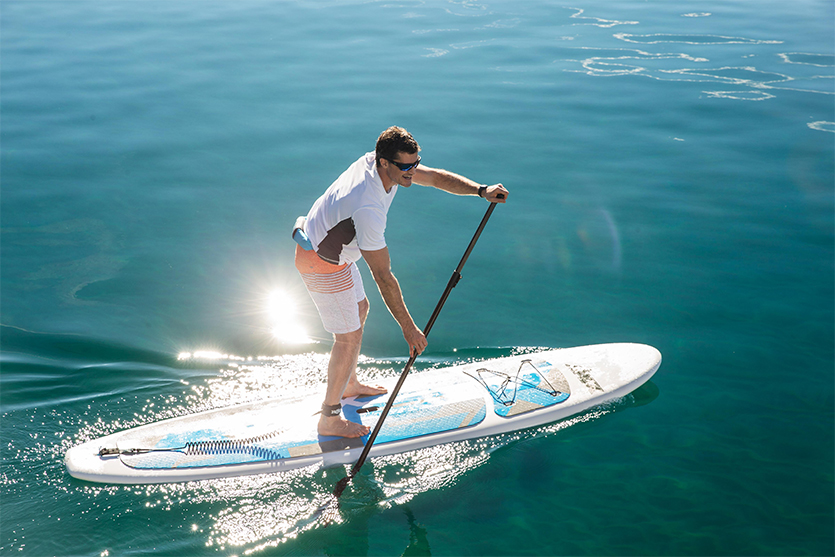
The forward stroke is the most basic and crucial to learning since you'll use it more frequently. It propels your board through the water to the direction you want to paddle.
To perform the forward stroke, if you're paddling on the left, place your left hand on the paddle shaft and your right hand on the top of the T- bar paddle grip. Then rotate your hips and shoulders and plant the paddle on the water surface.
Push the blade forward(now submerged), and when the blade is near your ankle, pull your paddle out of the water and repeat this process.
Ensure you keep your arms slightly straight, twist from your torso, and move in a straight line at a moderate speed.
Don't pull the paddle back with your lower arm. Instead, use your top hand to push down on the paddle grip. If you want to increase your speed, perform this process faster.
-
Reverse stroke
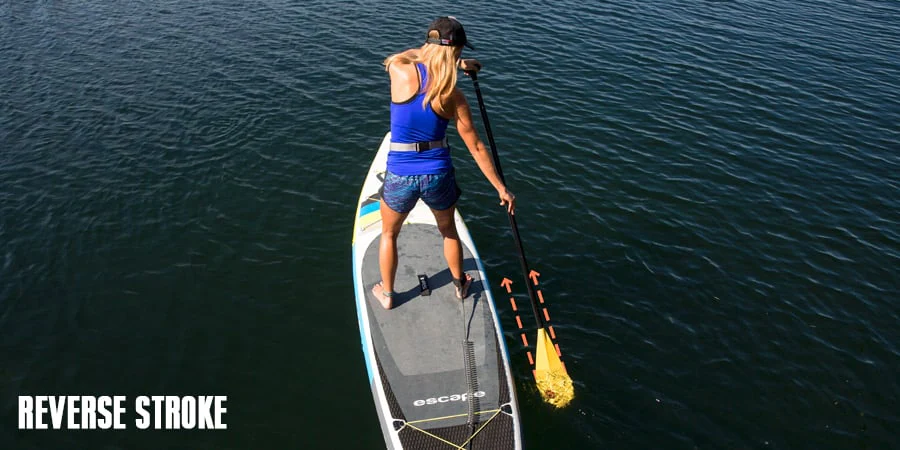
Performing a reverse stroke allows you to slow down, turn or stop. It is basically the opposite of a forward stroke. It involves performing the forward stroke but backwards.
To execute it, pull the paddle in the water close to the tail of your board. Once the paddle blade is submerged, keep your upper and lower arms straight and twist your torso.
Performing the reverse stroke on the left side of your board makes your board's nose slightly turn to the left and vice versa.
-
Sweep stroke
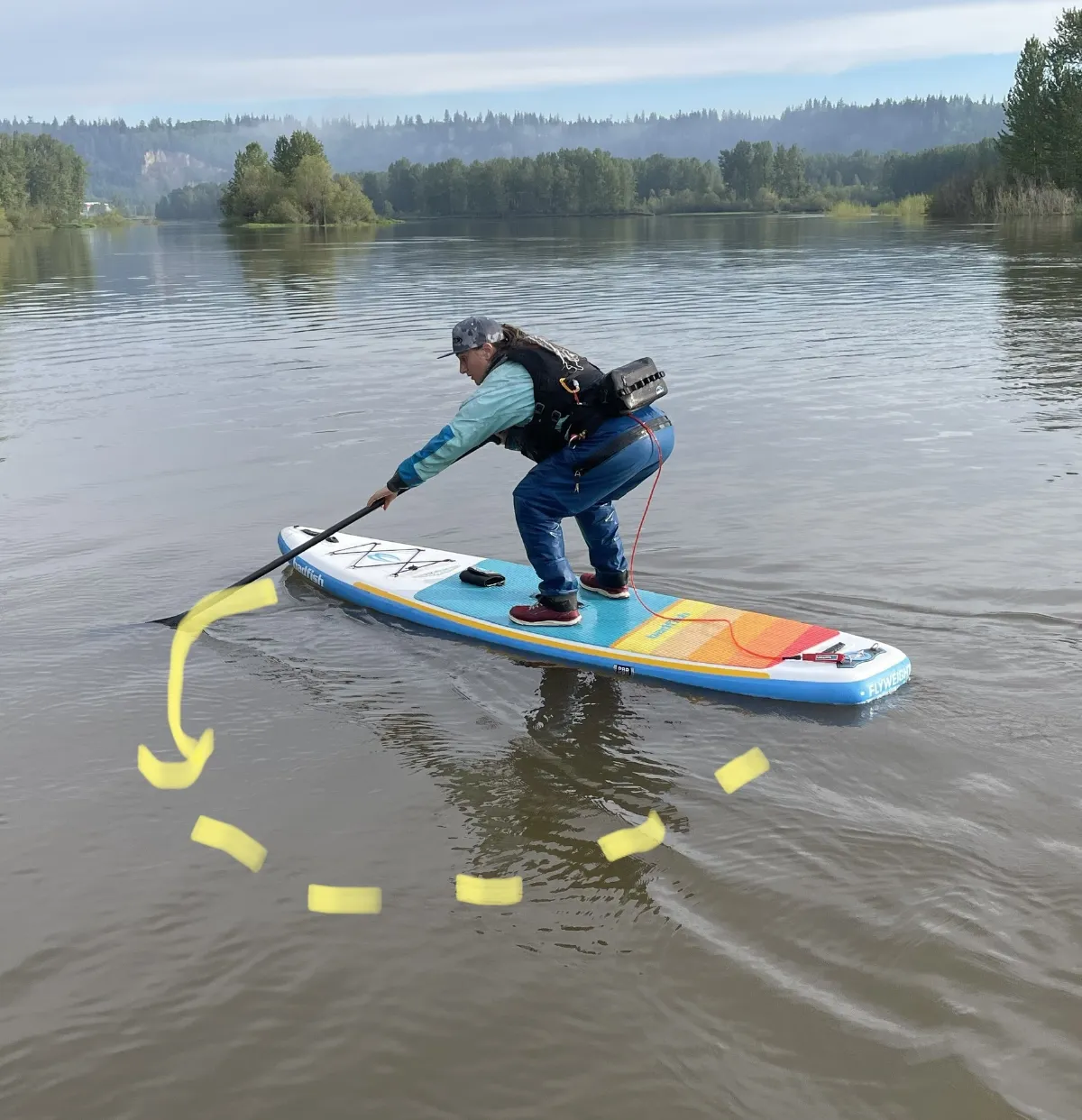
The sweep stroke is relatively easy to perform and is used to turn your board while moving or standing.
Here, bend your knees slightly and lower your arms, so the T-grip on the paddle is below your shoulder height. Plant the paddle in the water and submerge the blade facing your board's side.
Then sweep the paddle away from the board in half circle motion from the nose of the board towards the tail by using the leverage of your legs and hips and rotating your torso.
If you perform the sweep stroke on the right side of your board, the nose will go left and vice versa.
-
Draw stroke
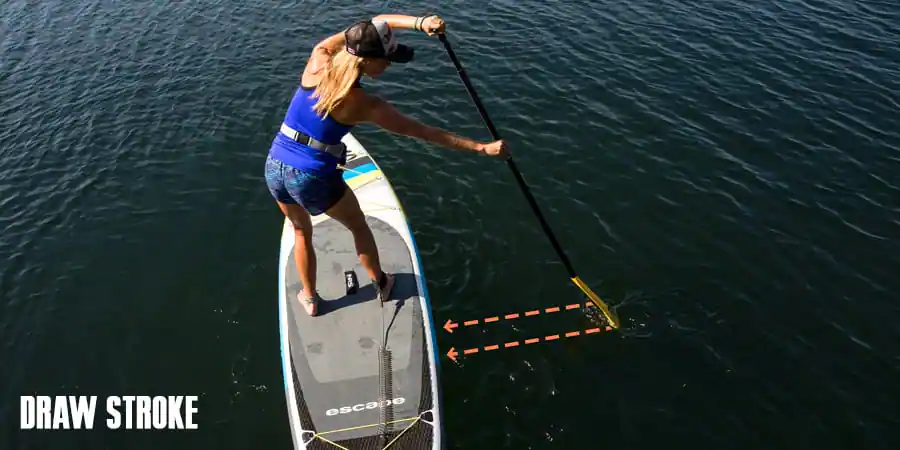
The draw stroke moves your boat sideways, and it's useful when you want to pull up alongside a boat or a dock or make a manoeuvre to change your direction.
To perform this stroke, rotate your shoulders in your desired direction and plant the paddle in the water. Ensure the paddle blade is parallel to the board. To move, pull the blade towards you and move the board in the paddling direction.
-
CrossBow stroke
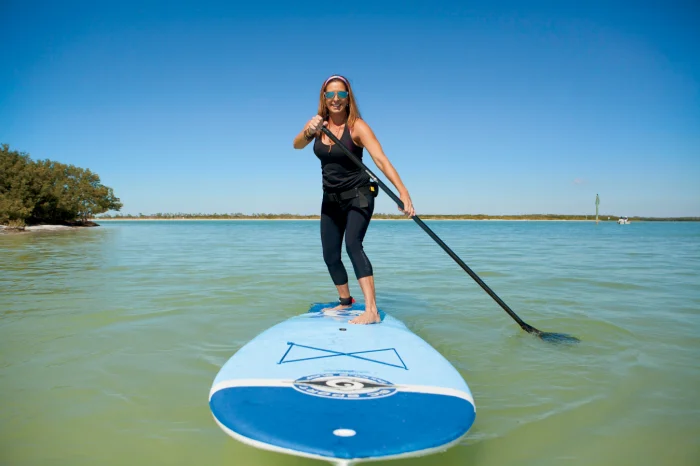
The crossbow stroke is more advanced and delivers an efficient and tight turn without changing your posture. This stroke is excellent if you want to make a quick direction adjustment while moving.
If you want to turn left, you'll need to paddle on your right side. Twist your body and bring the paddle over the nose of the board and submerge the blade in water on the left side of the board.
Bend your knees, rotate your torso to the right and pull the blade towards the nose of the board.
To turn to the right, start paddling from the left side.
How to Stand up on SUP
Before trying to stand up on your paddle board, you should start from a kneeling position. This gives you balance and helps you focus on paddle strokes.
-
Mount your board
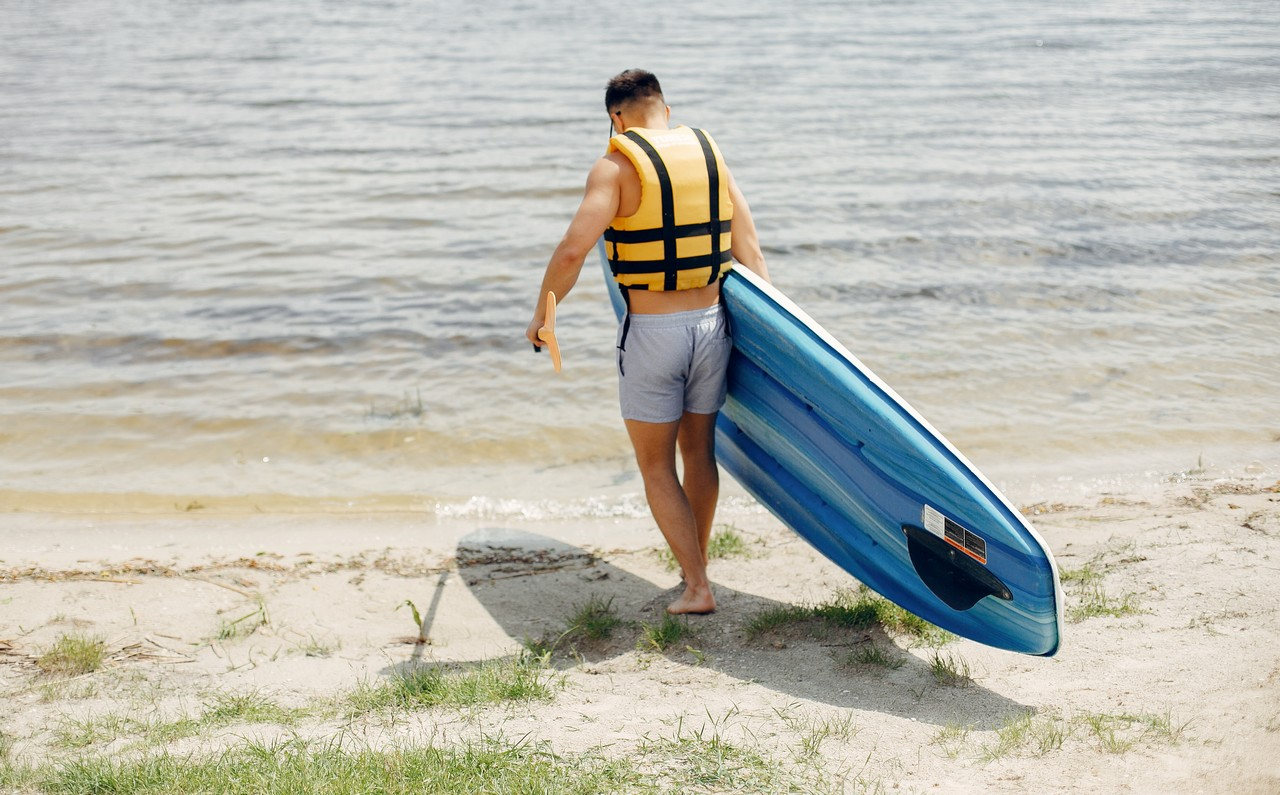
With your knees deep in water, stand on the side you feel most comfortable with and place the paddle across the board. Hold the board on the sides with the hand closest to your body, holding both the paddle and the board to help you maintain balance.
-
Practice Knee Paddling
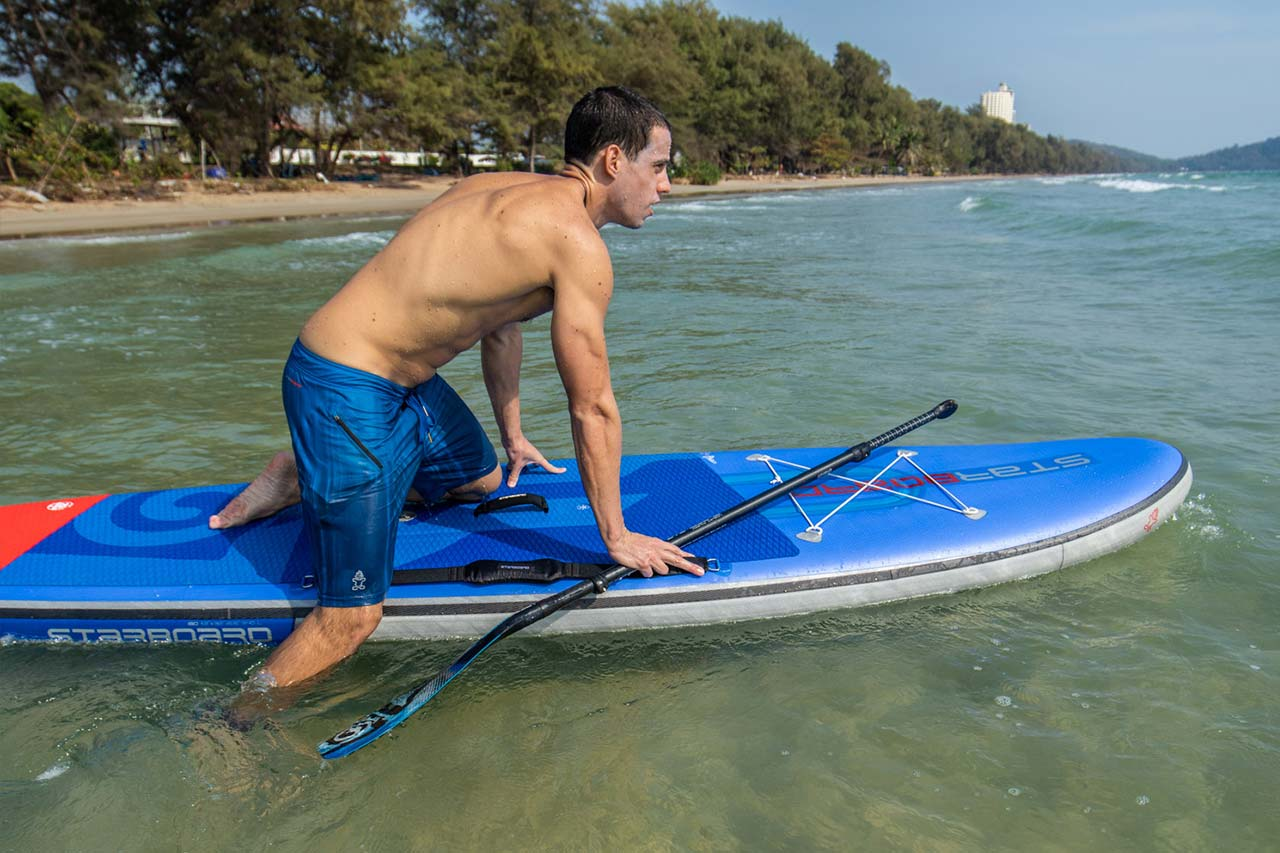
Now, lift one knee from the water and pull the board towards you, placing it on the board. Shift your body directly above the paddle board and bring the other knee on the board. With both knees on the board, and body weight central, hold the paddle grip at the top with one hand and the hand around halfway down.
Consider taking a few strokes and attempting to turn around so you get a feel of the board. Remember, the goal here is to ensure you're comfortable when paddling.
Practice on your knees for at least 10 minutes keeping your head up.
To begin standing up on your paddleboard, ensure your board is moving; therefore, paddle forward and gain some forward momentum while still on your knees.
-
Getting to Your Feet
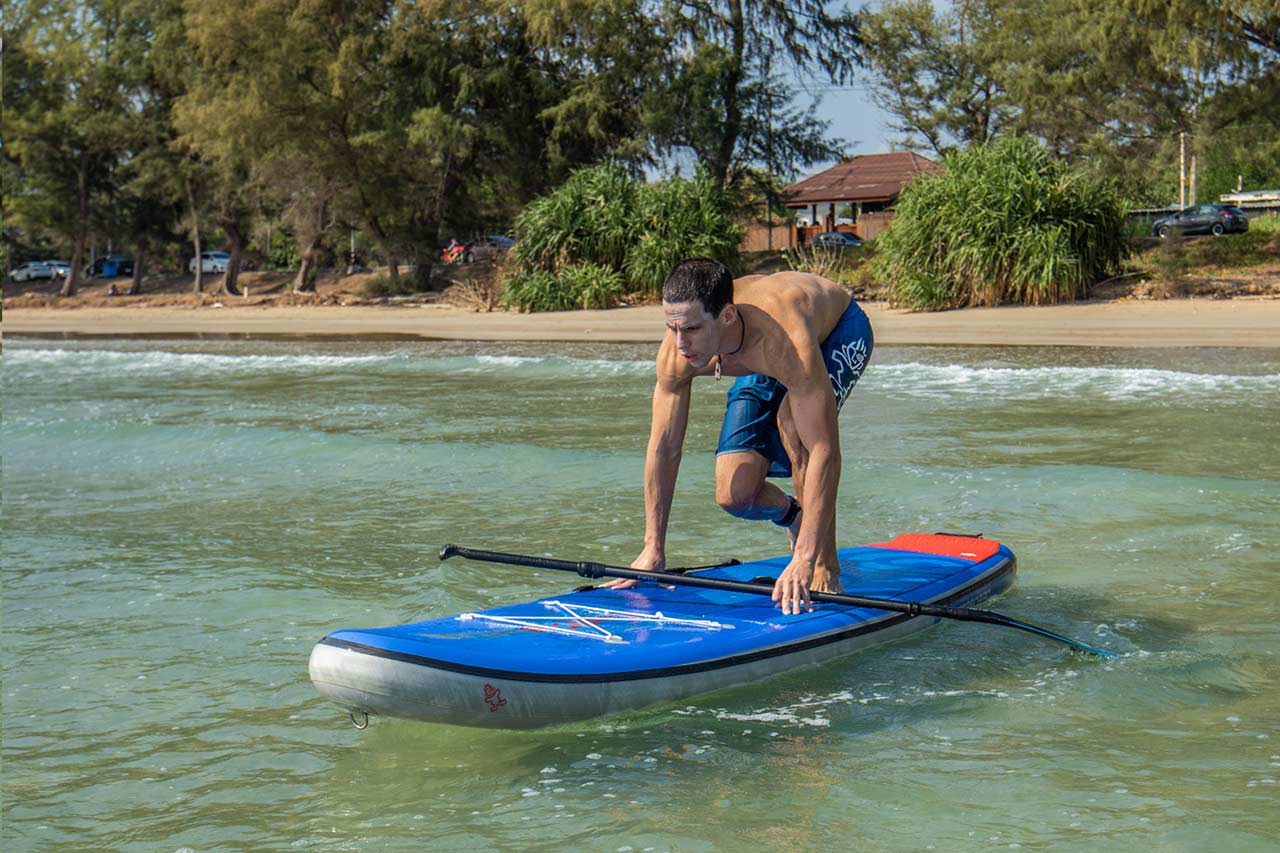
Move the top hand (which was on the paddle grip) and place your knuckles on the board around 2 feet from the knees. With your knuckles on the board, lean forward and place the paddle across the board. Once you're set, start by standing one foot at a time, knees somewhat bent and put your feet exactly where your knees were.
Keep your head looking forward and eyes out to the horizon to help you maintain a good body posture.
-
Standing upright
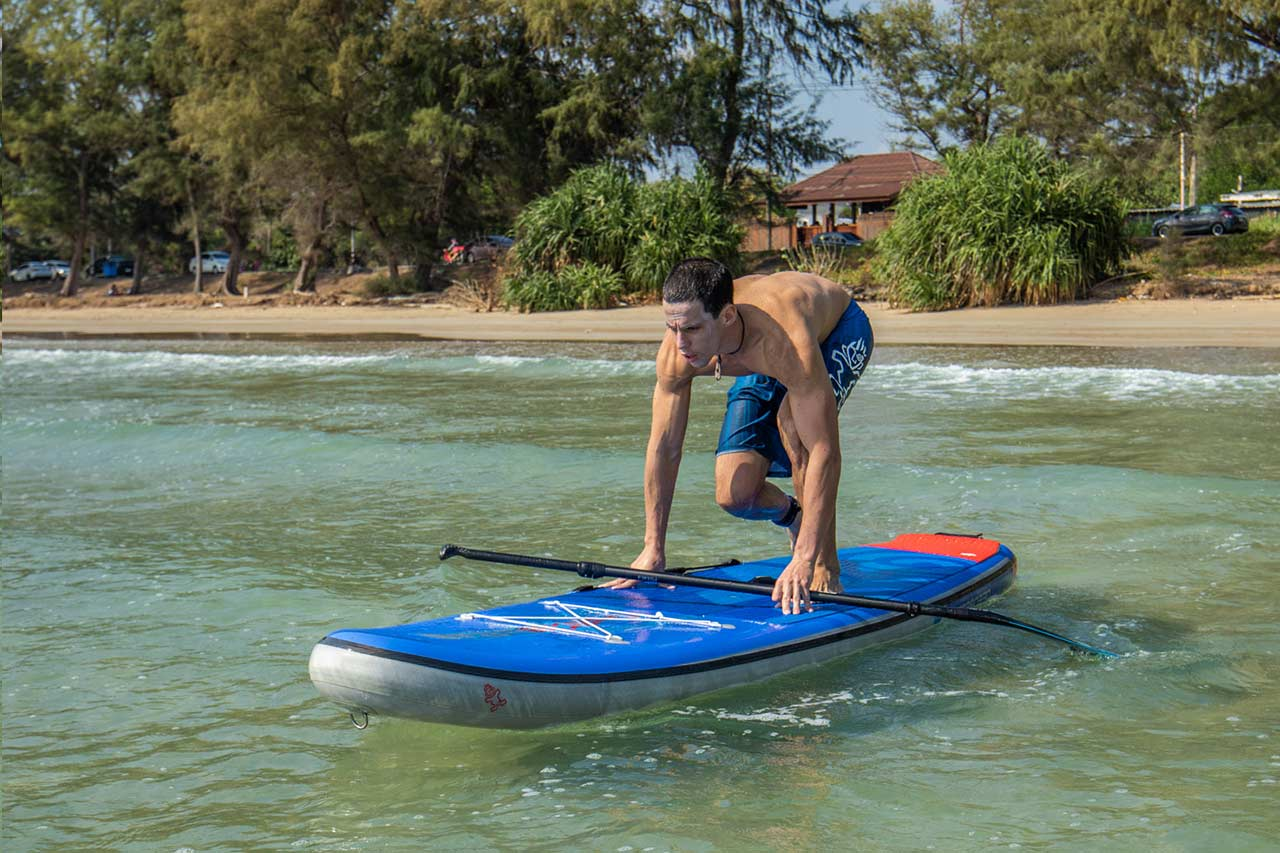
Rise to a standing position and slightly adjust your body to the perfect place to start paddling. Ensure your body is upright and central to the board. With your feet parallel, ankles loose, and knees a bit bent, keep your core centred on the board and ready to start paddling.
Keep your chest up and your eyes on the horizon, and don't stare at your feet. If you do this, your body will fold and strain your core muscles; hence may lose your balance.
-
Starting to Paddle

Hold the paddle grip with your top hand, and with the same paddle technique you used while on your knees, reach in the direction of the nose of the board and enter the blade fully in water. Pull the blade parallel to the board to align it with your feet.
Lift the paddle from the water back to the front of the board, and repeat the process.
Once you start moving forward, your body feels stable, making paddling easier. Try to perform five strokes on one side and switch to the other.
Hooray! You made it!
Helpful Tips for Staying Balanced on a SUP
-
Ensure you have the right equipment
-
Keep your knees a bit bent or flexed
-
Keep your eyes looking out at the horizon
-
Understand your board's center point
-
Pay attention to your breathing to reduce anxiety and keep you focused
-
Keep your body constantly moving
-
Practice balancing off the water
-
Ensure you're relaxed before and during paddling
5 Golden Rules for Stand-Up Paddling
-
Ensure you place your blade fully in the water before starting paddling. This applies to every stroke you perform.
-
Always use your core muscles when paddling to maintain your balance.
-
Assume a ready position when paddling by placing your feet shoulder-width apart.
-
Keep your board quiet on the water to help you stay focused and balanced.
-
Keep your back straight, and knees slightly bent to act as shock absorbers and keep you balanced.
Frequently Asked Questions
Is it easy to stand up on a paddle board?
Stand-up paddle boarding is an easy water sport to learn, but it's not effortless either. It comes in different styles, with some easier than others. The most common, recreational, or all-around paddle boarding is the easiest to learn and master.
Like any other type of water activity, it requires the right equipment and practising the technique.
Why can't I stand up on my paddleboard?
Having shaky legs while trying to stand up on your paddle is perfectly normal, especially if you're a beginner. However, one or more of the following elements could be the reasons:
-
You're using the wrong technique. You'll need to adjust your technique to ensure you balance your body.
-
Type and size of your SUP. The width, thickness, length and volume play a role in the stability of your board. Ensure you have the correct board type and size.
-
Paddling location and conditions such as wind and tides could affect your chances of standing up on your paddle board.
Stand up paddling is the most natural way to have fun above the water. While it may be challenging for beginners, mastering and practising the above paddle boarding tips will make you an expert paddler.
Once you've mastered the basics, you'll have endless opportunities to enjoy, from SUP yoga to surfing powerful waves and racing to SUP touring and whitewater adventures. The list is endless!
Grab your paddle board today and start your journey to your first SUP outing

